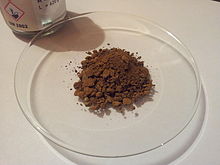Copper (II) chloride
| Crystal structure | ||||||||||||||||||||||
|---|---|---|---|---|---|---|---|---|---|---|---|---|---|---|---|---|---|---|---|---|---|---|

|
||||||||||||||||||||||
| __ Cu 2+ __ Cl - | ||||||||||||||||||||||
| Crystal system |
monoclinic (CuCl 2 , anhydrous) |
|||||||||||||||||||||
| Space group |
C 2 / m (No. 12) |
|||||||||||||||||||||
| Lattice parameters |
a = 690 pm |
|||||||||||||||||||||
| Coordination numbers |
Cu [6], Cl [3] |
|||||||||||||||||||||
| General | ||||||||||||||||||||||
| Surname | Copper (II) chloride | |||||||||||||||||||||
| other names |
|
|||||||||||||||||||||
| Ratio formula |
|
|||||||||||||||||||||
| Brief description |
|
|||||||||||||||||||||
| External identifiers / databases | ||||||||||||||||||||||
|
||||||||||||||||||||||
| properties | ||||||||||||||||||||||
| Molar mass | ||||||||||||||||||||||
| Physical state |
firmly |
|||||||||||||||||||||
| density |
3.39 g cm −3 |
|||||||||||||||||||||
| Melting point |
630 ° C (anhydrous) |
|||||||||||||||||||||
| solubility |
620 g l −1 (20 ° C) in water |
|||||||||||||||||||||
| safety instructions | ||||||||||||||||||||||
|
||||||||||||||||||||||
| MAK |
0.01 mg m −3 |
|||||||||||||||||||||
| Toxicological data | ||||||||||||||||||||||
| As far as possible and customary, SI units are used. Unless otherwise noted, the data given apply to standard conditions . | ||||||||||||||||||||||
Copper (II) chloride is a chemical compound and a copper salt of hydrochloric acid with the formula CuCl 2 . Anhydrous copper (II) chloride is a brown powder which is very hygroscopic . The incorporation of water molecules into its crystal structure creates the copper (II) chloride dihydrate , a blue-green solid with the formula CuCl 2 · 2 H 2 O. The anhydrous copper chloride melts in moist air to a brown paste, while the dihydrate is stable in air. The water of crystallization is expelled from the dihydrate by heating to over 100 ° C and the brown, anhydrous form remains.
There is also basic copper (II) chloride ( copper (II) oxychloride , Cu 2 Cl (OH) 3 ), which is insoluble in water and is referred to as a tetrahydrate as Braunschweig green .
In a burner flame , all compounds show a blue-green flame color , caused by the Cu 2+ ions.
Occurrence
Copper (II) chloride occurs naturally as the mineral tolbachite , the dihydrate is also known as the mineral eriochalcite . Both compounds are often associated with the copper ore atacamite .
Extraction and presentation
In the laboratory, copper (II) chloride can be produced from copper (II) oxide and hydrochloric acid or by dehydrating the dihydrate with thionyl chloride :
Technically, it is by chlorination of copper sheet obtained.
Copper (II) chloride can also be produced by simple electrolysis of sodium chloride with copper electrodes. The resulting elemental chlorine oxidizes the copper electrodes. When the solution evaporates, copper (II) chloride dihydrate is formed.
properties
Anhydrous copper (II) chloride occurs in the form of a brown to yellow powder; the dihydrate is turquoise. Both produce a green flame color due to the copper ions (Cu 2+ ) they contain .
The anhydrous copper (II) chloride crystallizes in the monoclinic crystal system with the space group C 2 / m (space group no. 12) in a distorted CdI 2 - structure . The distortion of the structure is caused by the Jahn-Teller effect , which is caused by the valence electron configuration (d 9 ) of the Cu 2+ ions. The anhydrous copper (II) chloride was the first compound in which a coordination polyhedron in the form of a (distorted) octahedron of six chloride anions around a Cu 2+ ion could be detected.
The copper (II) chloride dihydrate, on the other hand, crystallizes in the orthorhombic crystal system in the space group Pbmn (No. 53, position 3) . The Cu 2+ ions are surrounded by four Cl - ions in a square-planar manner, the two remaining corners of the distorted octahedron are occupied by the water molecules.
use
Copper chloride is used as a catalyst in organic syntheses, e.g. B. used in the production of the textile dye aniline black and oxychlorination . It is also used in pyrotechnics to produce green flames, in copper etching (in a mixture with hydrochloric acid), in photography for bleaching negatives , as a basic copper chloride in fruit growing and viticulture against fungal diseases and for removing soot from oil stoves.
proof
Copper (II) chloride is detected with ammonia water. Blue copper (II) hydroxide precipitates out, which dissolves again as tetraammine copper upon further addition.
Individual evidence
- ^ A b P. C. Burns, FC Hawthorne: Tolbachite, CuCl 2 , the first example of Cu 2+ octahedrally coordinated by Cl - . In: American Mineralogist. No. 78, 1993, pp. 187-189.
- ↑ a b c d e f g h Entry on copper (II) chloride in the GESTIS substance database of the IFA , accessed on April 1, 2016(JavaScript required) .
- ↑ Data sheet copper (II) chloride (PDF) from Merck , accessed on January 19, 2011.
- ^ Römpp: Basislexikon Chemie, Georg Thieme Verlag Stuttgart 1998, ISBN 3-13-115711-9
- ^ Alfred R. Pray: Anhydrous metal chlorides . In: Therald Moeller (Ed.): Inorganic Syntheses . tape 5 . McGraw-Hill, Inc., 1957, pp. 153-156 (English).
- ^ S. Brownstein, NF Han, EJ Gabe, Y. le Page: A redetermination of the crystal structure of cupric chloride dihydrate. In: Journal of Crystallography. No. 189, 1989, pp. 13-15.







